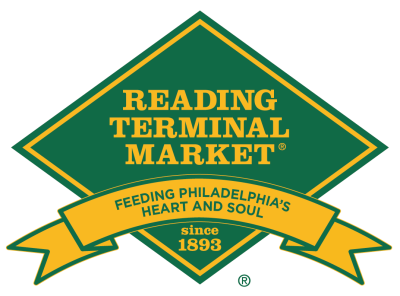30 tons of waste (more than 60,000 pounds) has been diverted in the first month PHILADELPHIA – Reading Terminal Market, Philadelphia’s historic public Market and…
Thank you for supporting our black-owned businesses! Amazulu Careda’s Caribbean Cuisine DeVillage Little Marrakesh Bazaar Ma Lessie’s Chicken & Waffles O.K. Produce Really Reel Ginger…
Offering a variety of jerky, including classic, bacon, brisket and a selection of exotic jerky options.
PHILADELPHIA – Reading Terminal Market, Philadelphia’s historic public market and a 501(c)(3) non-profit, will host its 12th Annual Party for the Market on Saturday, February…
Join PHL 17 each week as we take a few minutes to meet the owners and operators of one of the coolest markets in the…
Attendees will enjoy live music, axe throwing, a beer garden, and fall flavors galore PHILADELPHIA – Harvest Festival at Reading Terminal will take over Filbert…
Young Friends Taste and Tour Thursday, May 29th | 5 – 7PM Join Us for Beer, Wine & Good Times! Our beloved public market can…
Bassetts Ice Cream and nine other Philly ice cream staples will join forces for a day of fun PHILADELPHIA – One of America’s biggest ice…
You can vote once a day, every day. Voting ends on Monday, April 15
PHILADELPHIA – For the third year in a row Reading Terminal Market is in the running for USA Today’s 10Best title of Best Public Market…
PHILADELPHIA – Reading Terminal Market has welcomed a new culinary experience for locals and visitors with City Food Tours. This guided tour showcases the best…
Like all great cities, Philadelphia is the type of place that you can explore again and again (and again). Perhaps the only thing better than…
City Food Tours is the exclusive tour partner of the Reading Terminal Market. Come taste the Market’s history, hear stories of some of the 80+…
Looking for the perfect gift? A Reading Terminal Market gift card is a great option for anyone! Reading Terminal Market gift cards are accepted at…
You’ll see a familiar Philadelphia institution on PHL17 every week as part of our new partnership, Magras at the Market! Reporter Jayna Magras will be…
Updated: September 2022. General Reading Terminal Market strives to ensure that its services are accessible to people with disabilities. Reading Terminal Market has invested a…
Sparrow’s is a third generation family business, specializing in All Natural, Gluten Free snack foods and gifts made with the most premium ingredients. We’ll feed…
40+ Reading Terminal Market merchants deliver within a 10 mile radius through our delivery partner, Mercato. These merchants offer nationwide shipping Bassetts Ice Cream Famous 4th…
Reading Terminal Market celebrated its 130th year of operation
The streetscape outside the Market was enhanced to create a curbless “festival street” aimed at increasing public use of the 1100 block of Filbert St.
Reading Terminal Market operated as an essential business during the height of the COVID-19 pandemic ensuring Philadelphians had continued access to fresh, affordable food.
The Market Celebrates its 125th Anniversary on February 22nd.
The Reading Terminal Market celebrated 120 years of bringing fresh and local food to Philadelphia.
The Reading Terminal Market was 100% occupied, a result of growth in downtown residential population and tourism.
Non-profit Reading Terminal Market Corporation created to manage the market.
The adjacent Pennsylvania Convention Center opened and brought new customers to the market.
The Food Trust was founded as a program of the Reading Terminal Market
Pennsylvania Convention Center bought the Reading Terminal Market.
Supporters of the market organized The Reading Terminal Market Preservation Fund to ensure that the market retained its character as the convention center project developed.
The new Market East Station with rail and subway services connecting all major transportation lines opened underneath the market.
The last train left the Reading Terminal.
The market was 60% occupied and had become a center for charitable and seasonable food events and impromptu piano concerts.
The Reading Company emerged from bankruptcy, bought out the lease, and began to invest in the market.
Reading Terminal Market was only 20% occupied.
The Reading Company leased the Market to a real estate speculator 15 years. He raised rents driving out 30 of the 56 remaining merchants.
Reading Company declared bankruptcy and no longer invested in the upkeep of the market.
1970-1980: Preservationists who wanted to save the market battled with those who wanted to demolish it to advance the East Market Redevelopment plan
Informal markets formed around Front and High (Market) Streets near where farmers and fisherman brought their goods from southern New Jersey.
1950 – 1960 New local and federal regulations intended to improve safety of the food supply increased merchants’ cost of doing business.
Rationing during World War II brought episodic meat and dairy shortages to the nation
The market had 400 phone lines to take call-in orders.
Reading Terminal Market Merchants’ Association celebrated its fourth year in with the Third Food Show and Home -Progress Exposition with 140 exhibitors and 60,000 attendees….
The Reading Company invested in new doorways and six refrigerated show windows along Twelfth Street.
Merchants organized the Reading Terminal Market Merchants’ Association to stem the loss of business from the City’s new parking regulations and the downturn in the…
Reading Terminal Market advertised itself as the “Source of Main Food Supply of Philadelphia and Adjacent Territory” with 250 specialized dealers and 100 farmers occupying…
Train service began at the new Reading Terminal.

